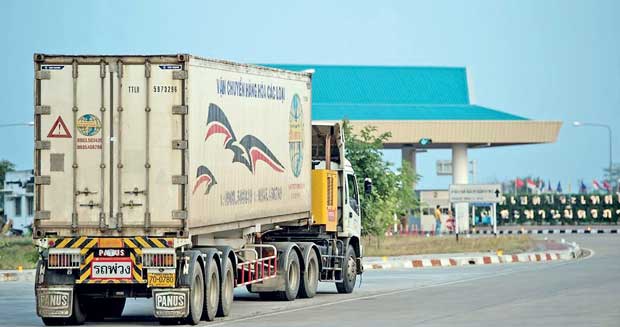24 Feb 2017 - {{hitsCtrl.values.hits}}

 A new chapter of Asia’s growth story is being written either side of the Ganges Delta. South Asia is rising. The People’s Republic of China (PRC) is striving to reach a new level. Along the Mekong, startling growth is reversing decades of stagnation.
A new chapter of Asia’s growth story is being written either side of the Ganges Delta. South Asia is rising. The People’s Republic of China (PRC) is striving to reach a new level. Along the Mekong, startling growth is reversing decades of stagnation.
There’s just one element missing that could elevate this growth curve to new heights, not just for Asia but globally. If India and other South Asian nations—collectively forecast to grow by 7.3 percent in 2017—can integrate their dynamic economies into the rest of Asia, they could lift the region to a higher plane of social and economic development – just as Japan and China led Asia into the modern economic era.
An economic engine of this size could potentially erase extreme poverty in the region. Removing obstacles to trade and investment between South Asia, Southeast Asia and other parts of Asia is the key to making this happen. If South Asia and Southeast Asia each cut non-tariff barriers by 50 percent and trade costs by 15 percent, gains in South Asia’s prosperity would total an impressive 8.9 percent of gross domestic product (GDP) and 6.4 percent of GDP in Southeast Asia.
The channel for that growth should run along India’s east coast, through Bangladesh and Myanmar into the rest of Southeast Asia and the PRC. Myanmar and Bangladesh are ideally located to open the economic floodgates between the economies on the southern side of Asia and those to the east.
These two countries are the connective tissue between Asia’s growth poles. Given the paucity of trade between South Asia’s constituent countries—only 5 percent of total trade is done with each other compared to 35 percent in East Asia and 26 percent in Southeast Asia—Asia’s next growth spurt is more likely to come from synching strengths across sub-regions in ways that compensate for their respective weaknesses.
This is happening, but not fast enough. Trade between the economies of South Asia and Southeast Asia climbed from just US $ 4 billion in 1990 to US $ 90 billion in 2013. But that’s just a fraction of the potential gains. Large economies on either side of the Ganges need to work harder to build the mutual trust, consensus and political commitment needed to forge closer trade and transport links.
South Asia can take some cues from its eastern neighbors. Their economies grew quickly even after the global financial crisis through new trade agreements, highways, shipping routes and cross-border logistics.
They plugged themselves into regional and global production networks – not just building products for export, but building components or adding value to products built in multiple countries and striking trade deals particularly between China and neighboring countries. They made it easier to communicate by phone and Internet connections between countries.
South Asia lacks the institutional framework provided by ASEAN, which has galvanized economic integration throughout Southeast Asia by liberalizing investment and trade regimes, pushing down production and logistics costs. Regional production networks have gravitated to Southeast Asia, attracted by differences in wage and labor productivity levels across countries.
To play an important role in global growth, South Asia’s economies need to be more tightly integrated with each other, with Southeast Asia and other parts of Asia. The Trilateral Highway connecting India, Myanmar and Thailand will deliver physical connectivity. But for such links to translate into efficient movement of goods it is crucial to develop more robust value chains with Southeast Asia and East Asia.
Market and institutional links are equally important. There has been progress, but more is needed. The Association of Southeast Asian Nations (ASEAN) and India have forged a free trade agreement to deepen trade in goods and services and strengthen investment ties. India is partnering with Myanmar to deepen maritime trade by developing Sittwe in northern Myanmar as a deep-sea port.
A host of new economic corridors are another key to connecting Asia’s fastest-growing countries. The Bangladesh-PRC-India-Myanmar economic corridor will spur economic integration. The 2,500 km East Coast Economic Corridor (ECEC) along India’s east coast includes the Vizag–Chennai Industrial Corridor, which could link into Bangladesh, Myanmar and China and finally to the ports of Viet Nam.
The ECEC’s strategically located ports provide an opportunity to develop multiple international gateways to connect India with global markets and value-chains. Matching the strengths of India’s northeast in products such as wood, rubber, cement and steel to ASEAN’s needs would maximize the ECEC’s potential as an eastern gateway. There is great scope also for economic corridors connecting India with Nepal, Bangladesh and Sri Lanka, to maximize the export earnings of these growing regional economies.
For all this to happen, behind-the border barriers to trade in South Asia need to be addressed, including better IT infrastructure and regulatory regimes to make it easier for businesses to grow, innovate and create much-needed jobs.
Asia’s growth poles will drive the global economy for years to come. By standing together, they can take the next step toward even greater prosperity.
(Wencai Zhang is Vice President Operations 1 of the Asian
Development Bank)
09 Jan 2025 49 minute ago
09 Jan 2025 2 hours ago
09 Jan 2025 3 hours ago
09 Jan 2025 3 hours ago
09 Jan 2025 3 hours ago